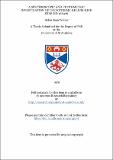A spectroscopic and photometric investigation of the extreme helium-rich star HD 168476
Abstract
Spectra were obtained from several sources for a fine abundance analysis of the extreme helium-rich star HD 168476. The atmospheric parameters are found using theoretical models and abundances determined for the ions identified in the spectra. The star is found to have an effective temperature of 14000°K, log(surface gravity) of 1.5 and a microturbulent velocity of 10 km/s. Over 1400 lines are identified on the spectra ranging in wavelength from 3100A to 4925A and 5490A to 6585A, and about 530 lines are suitable for the abundance analysis. It is confirmed that helium, carbon, nitrogen and neon are overabundant, with hydrogen and oxygen underabundant. An ultraviolet spectrum of the star is also obtained and lines identified. In addition to the ions found in the visible region of the spectrum, neutral ions are also present, indicating the possibility of a cool outer shell to the star. Photometric and spectroscopic observations are made to study the light and radial velocity of the star, to determine if it is variable. Statistical tests showed that the star is variable in its V magnitude, and most probably in its colours, as well as being variable in its radial velocity. No period is found and it is suspected that the variability may be complex. Several theories for the causes of the variability are discussed and a possible origin for the extreme helium-rich nature of the star mentioned.
Type
Thesis, PhD Doctor of Philosophy
Collections
Items in the St Andrews Research Repository are protected by copyright, with all rights reserved, unless otherwise indicated.

